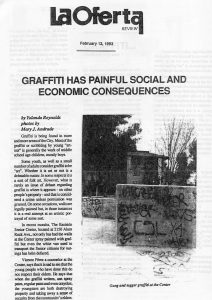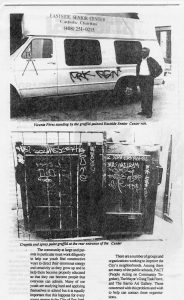February 13, 1993
By YoIanda Reynolds
Photos by Mary J. Andrade

Graffiti is being found in more and more areas of the City. Most of the graffiti or scribbling by young “artists” is generally the work of middle school age children, mostly boys.
Some youth as well as a small number of adults consider graffiti to be “art.” Whether it is art or not is a debatable matter. In some respects, it is a sort of folk art. However, what it appears – on other people’s property – and that is considered a crime unless permission was granted. 0n some occasions, walls are legally painted but, in those instances it is a real attempt at an artistic portrayal of some sort.
In recent month, The Eastside Senior Center, located at 2150 Alum Rock Ave., not only has had the walls at the Center spray painted with graffiti but even the white van used to transport the Senior citizens for outings has been defaced.
Vicente Perez a counselor at the Center, says that it is sad to see that the young people who have done this do not respect their elders. He says that when the graffiti writers use spray paint, regular paint and even crayolas, the youngsters are both destroying property and taking away a sense of security from the community’s elders.
For many elders, the Eastside Senior Center is like their home. They enjoy going there and the Center is a stress-free outing for them. Seeing messages from people that they don’t know nor have seen is disorienting and changes the atmosphere of a place that has always meant so much to them.
According to Dick De La Rosa, the Director of the San Jose Mayor’s Gang Task Force, there are two types of graffiti. One is done by taggers, youngsters who want to show they’re “cool” and daring by doing something illegal and by spray painting around town and the other type is the work of gangs who are marking a territory as their own. Both types of graffiti appear at the Center.
In any case, either intent is illegal but the one, gangs tagging is especially serious since gang boundary disputes can and have resulted in violence. Also disturbing is the fact that, frequently the controlling gangs like to feel that they can do whatever they wish in their territory.
According to De La Rosa, churches. community centers, and in particular, elder centers used to be off limits and respected. De La Rosa says that now these area are no longer immune to tagging by graffiti “artists”. Graffiti can now be found in every area of town. That, De La Rosa says, its sign of a lack of communication between parents and their children.
Vicente Perez, who also serves as a Deacon at a number of local Catholic churches, says that it is particularly alarming that the youthful offenders show so little respect for their elders.
Pérez adds that the children should realize that such behavior is disrespectful to the children’s own grand-parents and those of their friends.
For the many parents who care about the behavior of their children, it takes very special diligence to counter the enormous peer pressure on children to engage in tagging and gang activities.

One working mother, whose son was performing well in school, discovered that her son was not going home directly alter school. She was alerted to that fact by a watchful neighbor who had agreed to look out for her son in the event of an emergency. Like many families in the Valley, the young man’s parents both have full time jobs. The mother suspected that her son was doing something that he should not be doing with his after-school time, if he was not coming home. So, she took off from work and followed her son from school. To her dismay she discovered that he was tagging a freeway sound wall. When she confronted her son, he tried to explain his behavior by saying that “everyone tags and that, any way, the wall did not belong to anyone.”
His mother told her son that the wall did indeed belong to someone.
She explained to him that it was built with her taxes, those of her husband’s and the parents of his friends and that they all were the owners of the wall. She added that, not only did the wall belong to the community, but that it was the community that repainted that wall after it was defaced with spray painting. She explained that hundreds
of dollars are spent cleaning up graffiti that might better be spent on education.
De La Rosa says that vandalism, lack of respect and thoughtlessness for others is what graffiti represents. He adds that the problem will only reverse itself when parents become involved in the behavior and activities of their children.
Sometimes it takes sacrifice like the mother who took off from work to check up on her son. Sometimes it means saying “no” to an evening out even though its only for several hours.
Pérez says that the spray painting is especially problematical at the Senior Center because the costs of cleanup takes money away from the senior and community programs offered at the Center. It also frightens the senior citizens and many others in the community to understand that it is young people of their own community who deface the Center property. This is a place that is very important in the lives of the elderly. In addition, they feel hurt that those some young people could treat them with as little respect as they do the Center. The Center fills an important need in the community and every effort must be made to maintain it properly for our elders.
For those in the community (and there are many) who feel a special lover and gratitude for the work and sacrifices that our older people have made, it is offensive that anyone would take such liberties towards them whether or not they are a grandparent, parent, aunt or uncle.
The Eastside Senior Center has a gate and a fenced rear entrance of its building, but vandals have cut the chains and have removed the wrought iron bars from the fencing so often that the administration decided that it was best to leave the gate open, since all of their best efforts for security have been in vain and costly.
It is unfortunate that our youth are compelled to indulge in spray painting either for “getting up” (peer prestige) or to a claim a territory in a challenge to other gangs.
The community at large and parents in particular must work diligently to help our youth find constructive ways to direct their enormous energy and creativity as they grow up and to help them become properly educated so they can become people that everyone can admire. Many of our youth are studying hard and applying themselves in school but it is equally important that this happens for every young person in the City of San Jose.
There are a number of groups and organizations working to improve the City’s neighborhoods. Among them are many of the public schools. PACT (People Acting on Community Together), The Mayor’s Gang Task Force, and The Barrio Art Gallery. Those concerned with this problem and wish to help can contact these organizations. © La Oferta Newspaper.
